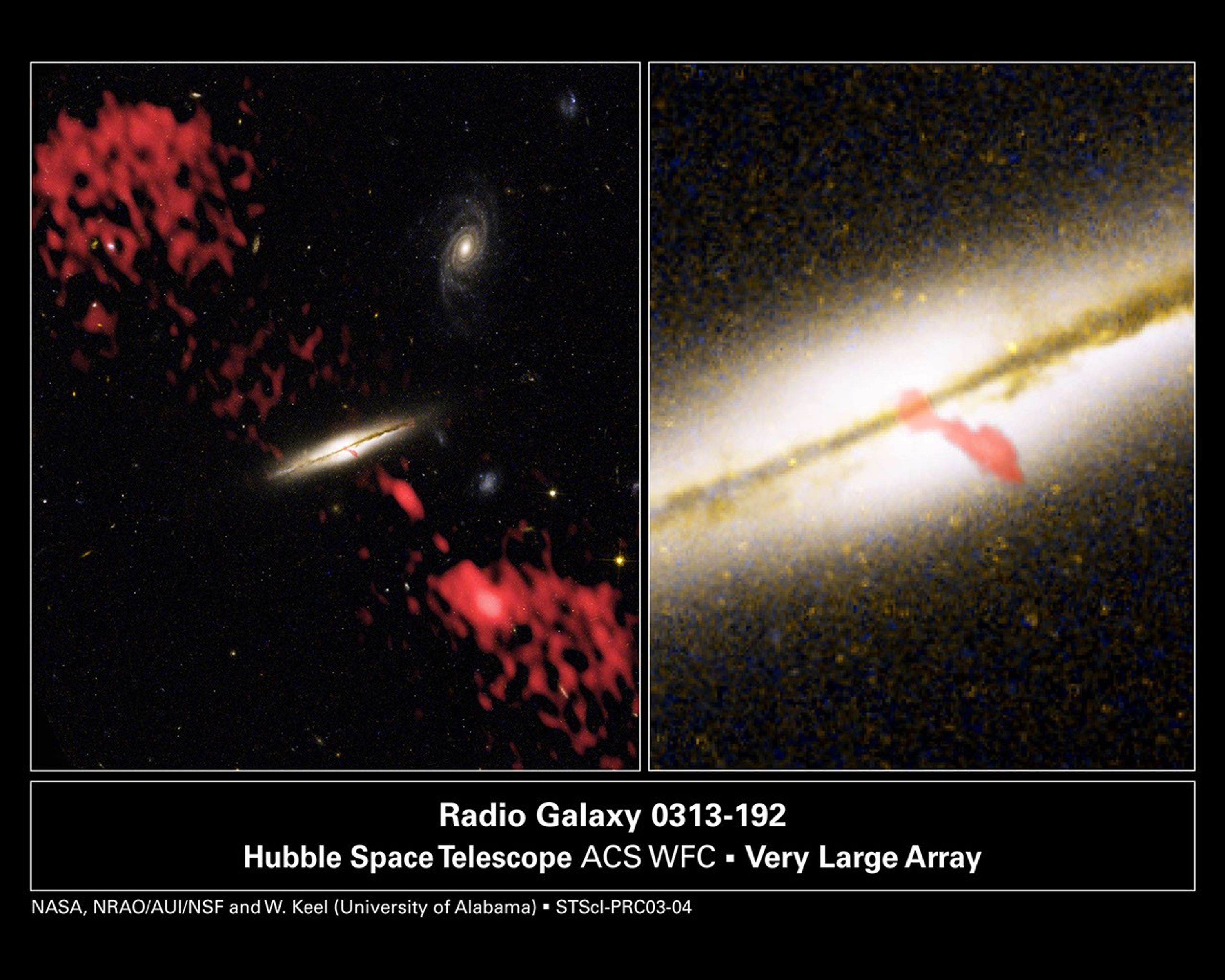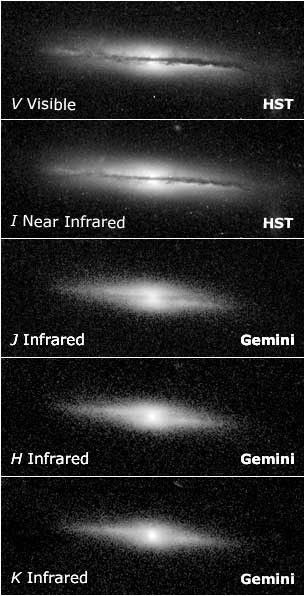1 min read
Spiral Galaxy 0313-192 Produces Giant Radio-Emitting Jet

Composite images showing the galaxy 0313-192, the first spiral galaxy known to be producing a giant radio-emitting jet. At left is a wide view of 0313-192 and its surroundings, as seen with the Advanced Camera for Surveys of the NASA Hubble Space Telescope (HST), in an image made in July 2002. The radio-emitting jet, as seen with the Very Large Array (VLA) at a wavelength of 20 centimeters, is overlaid, in red on the color image. The galaxy is seen edge-on. At right is a close-up of the HST image, with another red overlay from a higher-resolution, 3-centimeter VLA image, showing the inner portion of the jet. The prominent spiral galaxy in the upper right of the large-scale image is not related to 0313-192, nearly a billion light-years from Earth, but is more than 200 million light-years closer. The complex vertical structure of the absorbing dust and the blue star-forming regions past a warp in the dust lane confirm the spiral nature of the galaxy, even though it is seen edge-on.
About the Object
- R.A. PositionR.A. PositionRight ascension – analogous to longitude – is one component of an object's position.03h 15m 52.0s
- Dec. PositionDec. PositionDeclination – analogous to latitude – is one component of an object's position.-19° 6' 45.0"
- ConstellationConstellationOne of 88 recognized regions of the celestial sphere in which the object appears.Eridanus
- DistanceDistanceThe physical distance from Earth to the astronomical object. Distances within our solar system are usually measured in Astronomical Units (AU). Distances between stars are usually measured in light-years. Interstellar distances can also be measured in parsecs.900 million light-years (300 megaparsecs)
- DimensionsDimensionsThe physical size of the object or the apparent angle it subtends on the sky.The image is roughly 1.7 arcminutes (1.5 million light-years or 450 kiloparsecs) in width.
About the Data
- Data DescriptionData DescriptionProposal: A description of the observations, their scientific justification, and the links to the data available in the science archive.
Science Team: The astronomers who planned the observations and analyzed the data. "PI" refers to the Principal Investigator.Principal Astronomers: W. Keel, (U. Alabama, Tuscaloosa), M. Ledlow (Gemini Obs.) and F. Owen (NRAO) - InstrumentInstrumentThe science instrument used to produce the data.HST>ACS/WFC, and VLA (Radio)>"A" Configuration
- Exposure DatesExposure DatesThe date(s) that the telescope made its observations and the total exposure time.June 13-16, 2002, Exposure Time: 0.6 hours (HST), and November 5-7,1996, Exposure Time: 8.4 hours (VLA)
- FiltersFiltersThe camera filters that were used in the science observations.ACS: F555W (V) and F775W (I) VLA: 1400-MHz (L-band), 8.4-Ghz
- Object NameObject NameA name or catalog number that astronomers use to identify an astronomical object.0313-192
- Object DescriptionObject DescriptionThe type of astronomical object.Radio Galaxy
- Release DateJanuary 8, 2003
- Science ReleaseGiant Radio Jet Coming from Wrong Kind of Galaxy
- CreditNASA, W. Keel (University of Alabama), M. Ledlow (Gemini Observatory), F. Owen (NRAO) and AUI/NSF

Compass and Scale
Compass and ScaleAn astronomical image with a scale that shows how large an object is on the sky, a compass that shows how the object is oriented on the sky, and the filters with which the image was made.
Share
Details
Last Updated
Aug 17, 2025
Contact
Media
Claire Andreoli
NASA’s Goddard Space Flight Center
Greenbelt, Maryland
claire.andreoli@nasa.gov































